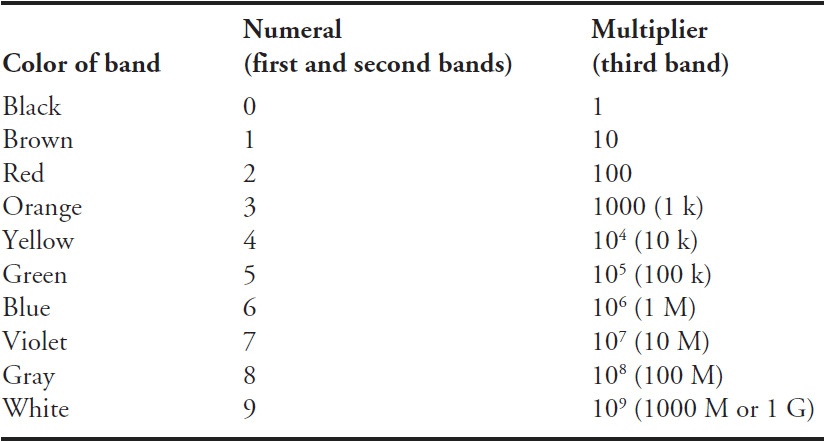B
Resistor color codes
Some resistors have color bands that indicate their values and tolerances. You’ll see three, four, or five bands around carbon-composition resistors and film resistors. Other resistors have enough physical bulk to allow for printed numbers that tell you the values and tolerances directly.
On resistors with axial leads (wires that come straight out of both ends), the first, second, third, fourth, and fifth bands are arranged as shown in Fig. B-1. On resistors with radial leads (wires that come off the ends at right angles to the axis of the component body), the colored regions are arranged as shown in Fig. B-2. The first two regions represent single digits 0 through 9, and the third region represents a multiplier of 10 to some power. (For the moment, don’t worry about the fourth and fifth regions.) Table B-1 indicates the numerals corresponding to various colors.
Table B-1
The color code for the first three bands that appear on fixed resistors. See text for discussion of the fourth and fifth bands

Suppose that you find a resistor with three bands: yellow, violet, and red, in that order. You can read as follows, from left to right, referring to the table:
• Yellow = 4
• Violet = 7
• Red = ×100
You conclude that the rated resistance equals 4700 ohms, or 4.7 k.
As another example, suppose you find a resistor with bands of blue, gray, and orange. You refer to Table B-1 and determine that:
• Blue = 6
• Gray = 8
• Orange = ×1000
This sequence tells you that the resistor is rated at 68,000 ohms, or 68 k.
If a resistor has a fourth colored band on its surface (#4 as shown in Fig. B-1 or B-2), then that mark tells you the tolerance. A silver band indicates ±10%. A gold band indicates ±5%. If no fourth band exists, then the tolerance is ±20%.
The fifth band, if any, indicates the maximum percentage by which you should expect the resistance to change after the first 1000 hours of use. A brown band indicates a maximum change of ±1% of the rated value. A red band indicates ±0.1%. An orange band indicates ±0.01%. A yellow band indicates ±0.001%. If the resistor lacks a fifth band, it tells you that the resistor might deviate by more than ±1% of the rated value after the first 1000 hours of use.
A competent engineer or technician always tests a resistor with an ohmmeter before installing it in a circuit. If the component turns out defective or mislabeled, you can prevent potential future headaches by following this simple precaution. It takes only a few seconds to check a resistor’s ohmic value. If you skip that simple step, build a circuit, and then discover that it won’t work because of some miscreant resistor, you might have to spend hours tracking it down!


